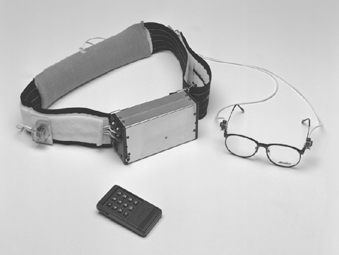
1996 Project Reports | Home | Contents | Previous | Next |
Eric E. Sabelman, PhD; Carol H. Winograd, MD; James Gadd, MS; Betty Troy, MS; David L. Jaffe, MS; Deborah Kenney, MS OTR; Sandy Dunn Gabrielli, BS; John Oehlert, MS
Objectives - Postural stability (balance) is an important factor in an individual's ability to function well in daily tasks. Impaired balance is indicative of increased fall risk, and may be due to disease accompanying aging. We have developed a portable light-weight accelerometric instrument (Fig. 1) to measure balance and record movement patterns in non-laboratory environments. We anticipate clinical use of this device to occur, first, as a diagnostic tool to quantify balance, second, as a biofeedback device to improve balance and gait, and third, as a fall-prevention aid.
Figure 1. Wearable computer with belt-mounted motion sensors, eyeglass-mounted sensors for head tracking, and remote control.
Methodology - The accelerometric motion detection system consists of two small 3-axis sensors attached to eyeglass frames for measuring head motion and two sensors on a velcro belt for body motion. Also on the belt is a self-contained data acquisition computer. An infrared remote control is used to command the computer to start and stop data acquisition and enter ID codes for data sets, so the wearer is unencumbered by cables. Data are downloaded to a fixed computer for analysis after a test session.
The accelerometric information is manipulated in a number of ways to provide quantitative measures of stability. The importance of various measures is determined by the complexity of the activity studied. For example, for quiet standing, a static activity, forward (pitch) and side-to-side (sway) angles are calculated. For dynamic activities, such as sit-to-stand (Fig. 2), we consider the multidimensional accelerometric signal as a time-varying pattern, much as is done for speech recognition. We have also measured simultaneous accelerometric and force platform data to show that horizontal waist measures correlate to changes in center of pressure.
Figure 2. Normal elderly subject performing standardized sit-to-stand task.
Progress/Status
Hardware development
A second generation device now under development will incorporate advances in technology to improve size, speed, and power consumption of the wearable computer. The second-generation device will feature pulse-output acceleration sensors, semi-custom digital signal processing (Altera) chips, and PCMCIA memory cards. The Altera chips perform time integration, scaling and transfer of data to the computer for storage, and can detect peaks in any channel's signal in real-time. The removable PCMCIA data storage card can be plugged into a fixed computer for analysis of patient data, eliminating the slow serial data transfer process required by the current system.
Post-test data analysis
A team of Stanford students explored pattern recognition applied to the acceleration signal, resulting in a new algorithm for encoding repetitive activities and a technique for identifying the transition between motion patterns. We are continuing to develop new algorithms for analyzing complex dynamic activities.
Subject testing
We have tested subjects as they performed all or part of a battery of 65 standardized activities, including standing, reaching, sitting, and simulated activities of daily living. The baseline healthy subject pool consisted of 18 elderly (over age 60) and 12 young (under age 40) individuals. Balance-impaired subject groups included Parkinson's disease patients (20 subjects), and hip prosthesis patients (20 subjects), stroke patients (4 subjects), and subjects in a study on physical activity and its relation to fall risk (17 subjects).
An example of vector magnitude of each three-axis accelerometer is plotted versus time in Fig. 3 for a normal 59 year old male performing a single sit-to-stand motion. Initiation of motion is evident at 1.0 seconds, followed by flexion at the waist and forward acceleration of the upper body (1.4 to 1.5 sec.). The head must travel a greater vertical distance than the waist, which is reflected in higher upward acceleration (at 1.66 sec.) as the hips and knees extended, bringing the body to an upright posture (2.1 to 2.2 sec.). After a short settling period (2.2 to 2.5 sec.), only small movements associated with quiet standing were recorded. Tests of sit-to-stand by an able-bodied volunteer subject first complying with and then violating the restrictions on hip motion (prohibition of hip flexion past 90°, adduction, and internal rotation) required of acute hip arthroplasty patients showed that these motion patterns could be distinguished.
Figure 3.Vector magnitude of head and waist sensors during sit-to-stand task.
Multi-site research collaborations
We have formalized the exchange of software, raw data, and interpretation techniques among 12 groups of researchers who have requested accelerometric motion analysis equipment for testing of diverse elderly populations. Among them are the Travelers Center on Aging at University of Connecticut Health Center, the Department of Movement Sciences and Education at Teachers College of Columbia University, and Zablocki VAMC, Madison, WI.
Future Work - We feel that the accelerometric system/method is sufficiently mature that our efforts can be focused on integrating accelerometric motion analysis into the rehabilitation of a single patient population. We have therefore submitted a new proposal, to enhance functional restoration and predict fall risk following hip replacement. A second proposal will demonstrate statistical accuracy and repeatability of summary scores calculated from accelerometric data.
In addition to its use as a diagnostic and therapeutic tool for balance-impaired elderly individuals, real-time accelerometric pattern analysis and feedback can be applied to prevention of occupational injuries, and to athletic training. We are seeking industrial partners to support development and clinical trial of these applications by means of Co-operative R&D Agreements.
Republished from the 1996 Rehabilitation R&D Center Progress Report. For current information about this project, contact: Eric E. Sabelman.